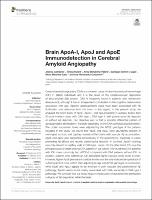| dc.contributor | Vall d'Hebron Barcelona Hospital Campus |
| dc.contributor.author | Camacho Soriano, Jessica |
| dc.contributor.author | Moline Marimon, Teresa |
| dc.contributor.author | Bonaterra Pastra, Anna |
| dc.contributor.author | Ramon y Cajal Agüeras, Santiago |
| dc.contributor.author | Martinez Saez, Elena Antima |
| dc.contributor.author | Hernandez Guillamon, Maria Mar |
| dc.date.accessioned | 2019-05-24T09:52:10Z |
| dc.date.available | 2019-05-24T09:52:10Z |
| dc.date.issued | 2019-03-13 |
| dc.identifier.citation | Camacho J, Moliné T, Bonaterra-Pastra A, Ramón y Cajal S, Martínez-Sáez E, Hernández-Guillamon M. Brain ApoA-I, ApoJ and ApoE Immunodetection in Cerebral Amyloid Angiopathy. Front Neurol. 2019;10:187. |
| dc.identifier.issn | 1664-2295 |
| dc.identifier.uri | https://hdl.handle.net/11351/4084 |
| dc.description | ApoA-I; ApoE; Cerebral amyloid angiopathy |
| dc.description.abstract | Cerebral amyloid angiopathy (CAA) is a common cause of lobar intracerebral hemorrhage (ICH) in elderly individuals and it is the result of the cerebrovascular deposition of beta-amyloid (Aβ) protein. CAA is frequently found in patients with Alzheimer's disease (AD), although it has an independent contribution to the cognitive deterioration associated with age. Specific apolipoproteins (Apo) have been associated with Aβ fibrillization and clearance from the brain. In this regard, in the present study, we analyzed the brain levels of ApoE, ApoA-I, and ApoJ/clusterin in autopsy brains from 20 post-mortem cases with CAA type I, CAA type II, with parenchymal Aβ deposits or without Aβ deposits. Our objective was to find a possible differential pattern of apolipoproteins distribution in the brain depending on the CAA pathological presentation. The protein expression levels were adjusted by the APOE genotype of the patients included in the study. We found that ApoE and ApoJ were abundantly present in meningeal, cortical, and capillary vessels of the brains with vascular Aβ accumulation. ApoE and ApoJ also deposited extracellularly in the parenchyma, especially in cases presenting Aβ diffuse and neuritic parenchymal deposits. In contrast, ApoA-I staining was only relevant in capillary walls in CAA type I cases. On the other hand, ICH was the principal cause of death among CAA patients in our cohort. We found that CAA patients with ICH more commonly had APOEε2 compared with CAA patients without ICH. In addition, patients who suffered an ICH presented higher vascular ApoE levels in brain. However, higher ApoE presence in cortical arteries was the only independent predictor of suffering an ICH in our cohort after adjusting by age and APOE genotype. In conclusion, while ApoE and ApoJ appear to be involved in both vascular and parenchymal Aβ pathology, ApoA-I seems to be mainly associated with CAA, especially in CAA type I pathology. We consider that our study helps to molecularly characterize the distribution subtypes of Aβ deposition within the brain. |
| dc.language.iso | eng |
| dc.publisher | Frontiers Media |
| dc.relation.ispartofseries | Frontiers in Neurology;10 |
| dc.rights | Attribution-NonCommercial-NoDerivatives 4.0 International |
| dc.rights.uri | http://creativecommons.org/licenses/by-nc-nd/4.0/ |
| dc.source | Scientia |
| dc.subject | Cervell - Malalties - Aspectes immunològics |
| dc.subject | Vasos sanguinis - Malalties - Aspectes immunològics |
| dc.subject | Apolipoproteïnes |
| dc.subject.mesh | Cerebral Amyloid Angiopathy |
| dc.subject.mesh | /immunology |
| dc.subject.mesh | Apolipoprotein A-I |
| dc.subject.mesh | Apolipoproteins E |
| dc.title | Brain ApoA-I, ApoJ and ApoE Immunodetection in Cerebral Amyloid Angiopathy |
| dc.type | info:eu-repo/semantics/article |
| dc.identifier.doi | 10.3389/fneur.2019.00187 |
| dc.subject.decs | angiopatía amiloide cerebral |
| dc.subject.decs | /inmunología |
| dc.subject.decs | apolipoproteína A-I |
| dc.subject.decs | apolipoproteínas E |
| dc.relation.publishversion | https://www.frontiersin.org/articles/10.3389/fneur.2019.00187/full |
| dc.type.version | info:eu-repo/semantics/publishedVersion |
| dc.audience | Professionals |
| dc.contributor.organismes | Institut Català de la Salut |
| dc.contributor.authoraffiliation | [Camacho J, Moliné T, Ramón Y Cajal S, Martínez-Sáez E] Servei d’Anatomia Patològica, Hospital Universitari Vall d'Hebron, Barcelona, Spain. Universitat Autònoma de Barcelona, Barcelona, Spain. [Bonaterra-Pastra A, Hernández-Guillamon M] Laboratori de recerca en malalties neurovasculars, Vall d’Hebron Institut de Recerca, Barcelona, Spain. Universitat Autònoma de Barcelona, Barcelona, Spain. |
| dc.identifier.pmid | 30918495 |
| dc.identifier.wos | WOS:000461093800001 |
| dc.rights.accessrights | info:eu-repo/semantics/openAccess |

